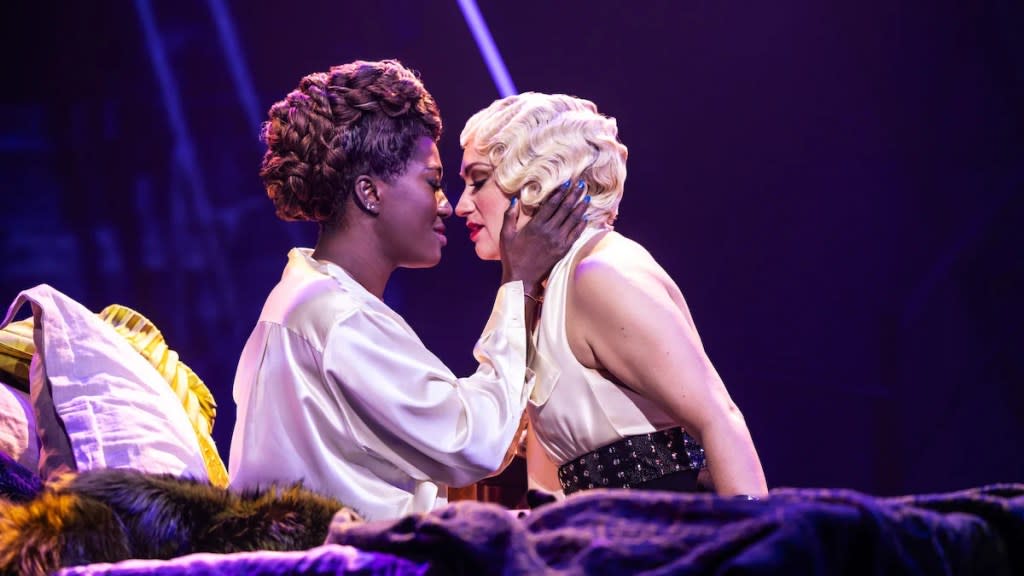‘Lempicka’ Broadway Review: Lesbians Get Their Big Musical Moment, Finally

If ever a big Broadway musical featured a show-stopping number set in a lesbian bar, I missed it. Kissing and hugging women, plus a few crossdressing men, finally take the spotlight in the new musical “Lempicka,” which opened Sunday at the Longacre Theatre.
I didn’t have to wait quite so long to see a musical number set in a gay bar. For me, that momentous moment came in the 1970 musical “Applause,” based on the movie “All About Eve,” in which Margo Channing (in the person of Lauren Bacall) holds court at one.
Followers of Sappho, welcome to the world of musical theater! It’s only 2024.
Even better than the lesbian bar song, very generically titled “Women,” is a duet that comes later in “Lempicka.” The Polish Art Deco painter who calls herself Tamara de Lempica (Eden Espinosa) has a husband (Andrew Samonsky) whom she loves, and she prostituted herself in order to get him out of some prison in Russia during the 1917 revolution. The couple flees to Paris, where Tamara, now the toast of the art world there, takes a female lover (Amber Iman), who quickly becomes her muse. When the husband and the girlfriend finally meet, it seems right that there should be fireworks.
Instead, the composer-lyricist Carson Kreitzer and lyricist Matt Gould give the pair a very civilized song to sing, and the more measured Iman and Samonsky become in their confrontation, the more the song “What She Sees” drips with irony, comeuppance and contempt. It’s a great book song because it’s not only tuneful but filled with action and character.
Earlier in “Lempicka,” Kreitzer and Gould give Iman and Samonsky solo turns that are also effective in a most understated way. Iman’s delivery of “The Most Beautiful Bracelet” is a case study in why it’s human nature to covet what we can never really get our hands on. If there’s any justice in the world of musical theater, we will be hearing many covers of “The Most Beautiful Bracelet” in the years to come.
And now for the other shoe to drop. Why have Kreitzer and Gould given their Lempicka nothing but loud, caterwauling screeds to sing? Once upon a time, Espinosa played Elphaba in “Wicked” on Broadway, and here, she appears stuck trying to top “Defying Gravity” in one female empowerment anthem after another. We get it! Tamara de Lempicka is a most liberated woman.
Only when the title character is off the stage are we able to give our ears a respite from all the noise. Equally loud but even more grating is the performance of George Abud, who plays a Nazi Emcee on leave from “Cabaret.”
Kreitzer and Gould also provide the book, which is one of those stories that gives five minutes to the Russian revolution, five minutes to the Great War, and five minutes to Futurism, the genesis of which came about two decades earlier than explained in the song “Perfection,” an ode to airplanes and cars that’s shouted by Abud. The point appears to be that Lempicka turned naked women’s bodies into airplanes and cars, or vice versa.
Except for the show’s best songs – “The Most Beautiful Bracelet” and “What She Sees” – Remy Kurs’ arrangements and Cian McCarthy’s orchestrations give a disco overlay to the music. It’s of a piece with Paloma Young’s costumes, which recall Madonna’s video “Vogue,” and Riccardo Hernandez’s set, which recalls The Saint disco in the East Village.
Rachel Chavkin’s direction of her lead actors is all over the place: Iman and Samonsky are assured and spot-on, Espinosa is undefined and Abud is so egregiously over the top that he’s guaranteed a Tony nomination. Chavkin’s employment of the chorus relies heavily on Raja Feather Kelly’s choreography, and his work brings a nice fascistic flourish to the goings-on. As Kreiter and Gould’s book makes clear, there isn’t that much difference between Lempicka’s art and the Futurism favored by Mussolini’s Italy.
At the end of “Lempicka,” our heroine finds herself stuck on a park bench in Los Angeles in 1975. She complains about having to live in such a vacuous place (Broadway audiences love it when L.A. gets trashed) and she laments having been forgotten. No one is interested in commissioning portraits from her anymore. Not asked is why she stops painting. Because nobody is paying her? Some artist.
In fact, the real Lempicka continued painting and experimenting with new styles. She led a very peripatetic life and spent about as much time in Los Angeles as she did in Texas and Mexico. She was not forgotten because of her sex. All Art Deco artists took a hit before the genre enjoyed a major resurgence more than a decade before Lempicka’s death at age 81 in 1980. Galleries around the world were already featuring major retrospectives of this artist’s work, most notably the Luxembourg Gallery in Paris in 1972.
In the end, “Lempicka” takes a potentially fascinating character and turns her into another weepy, boring victim.
The post ‘Lempicka’ Broadway Review: Lesbians Get Their Big Musical Moment, Finally appeared first on TheWrap.

